-
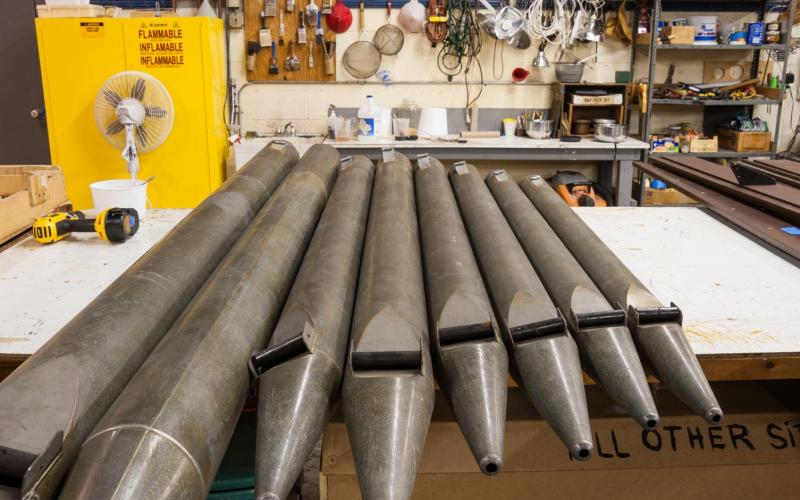
Pipes of the 8-foot Geigen Diapason await cleaning and repair in the shop. This is the first time these pipes have been out of the organ since they were installed in 1903.
-
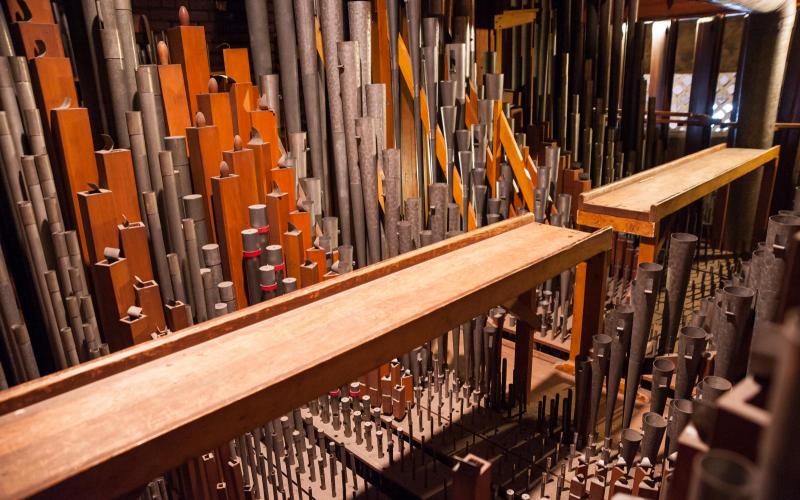
Swell Organ with façade grillwork. The two “perches” that straddle the two windchests permit the organ curators to reach every pipe for tuning.
-

Associate organ curator Nicholas Thompson-Allen prepares delicate pipes for transport in special blankets and wooden crates.
-
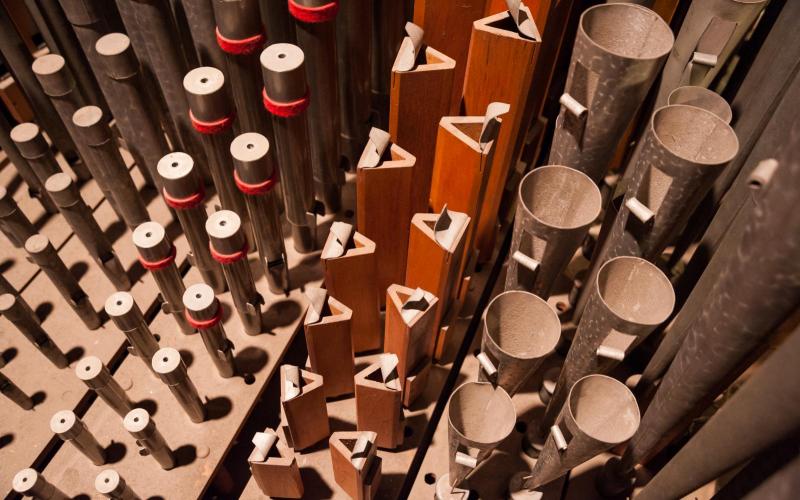
Pipework pre-resoration. L to r: 16’ Posaune, 4’ Clarion, 4’ Flute Triangulaire, 8’ Rohrflöte, 8’ Quintadena
-
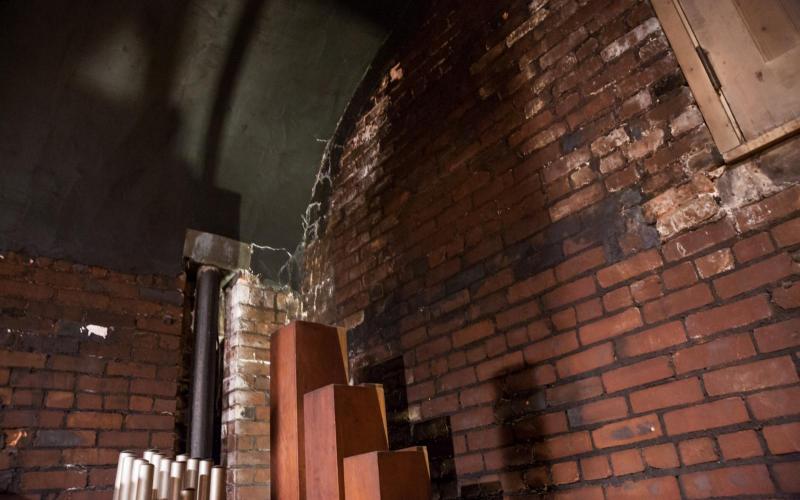
Water damage is visible on the masonry of the chamber walls. No one has passed through the door (upper right) since 1915 when storm windows were installed over it.
-
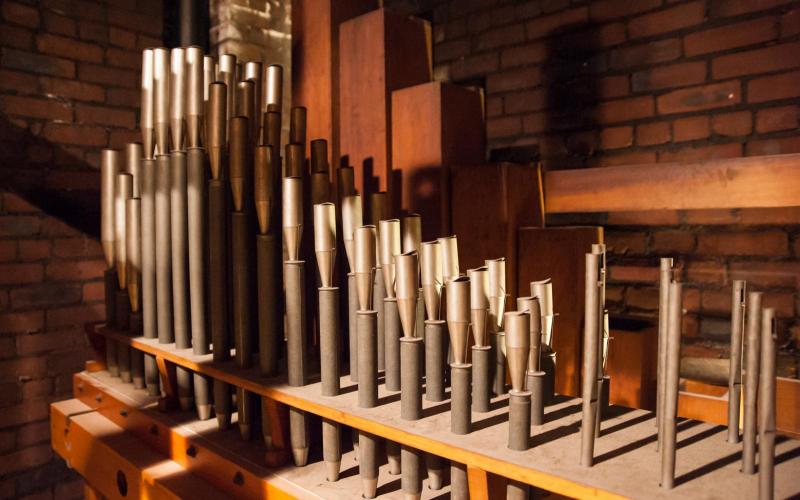
Vox Humana (Human Voice) pipes before restoration. Note the dust on the pipes and their windchest, as well as the water damage to the masonry wall behind the bass pipes in the photo.
-
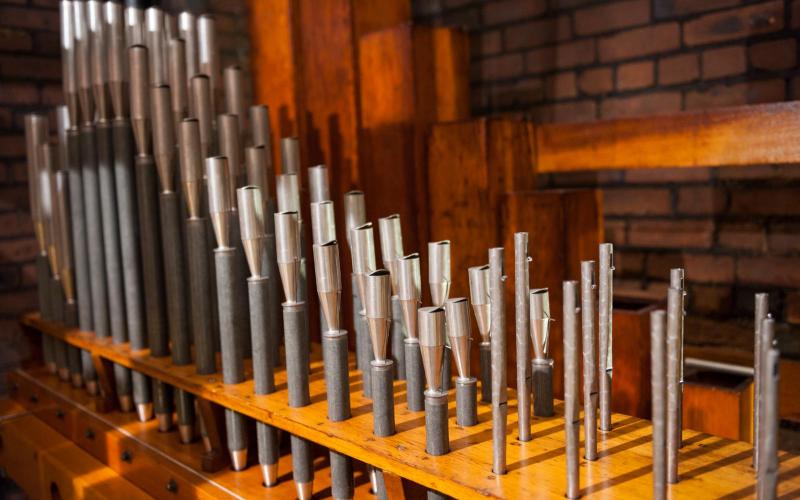
Following restoration the pipes and windchest for the Vox Humana shine like new. The cleaning process has returned the original sheen to the sound of the organ that gradually had been muffled by the accumulation of dust.
-
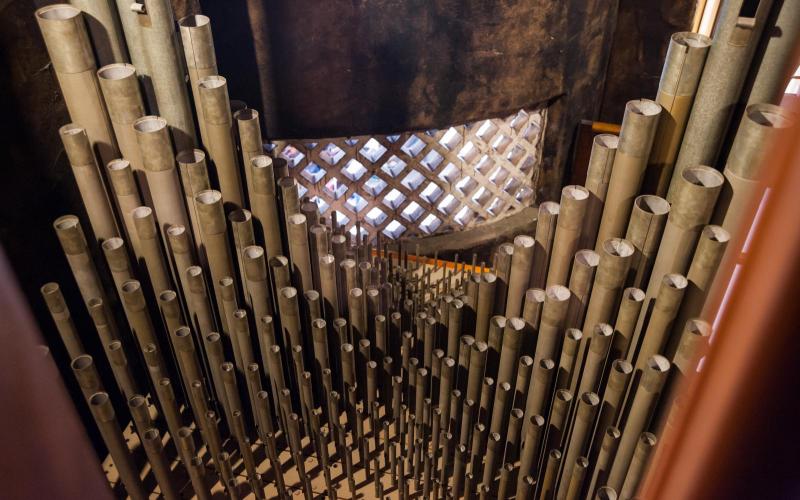
The Pedal Organ’s “mixture” pipework was a rarity in 1928. These pipes sound various pitches of the natural harmonic series, adding a special tint to the sound of the Pedal Organ.
-
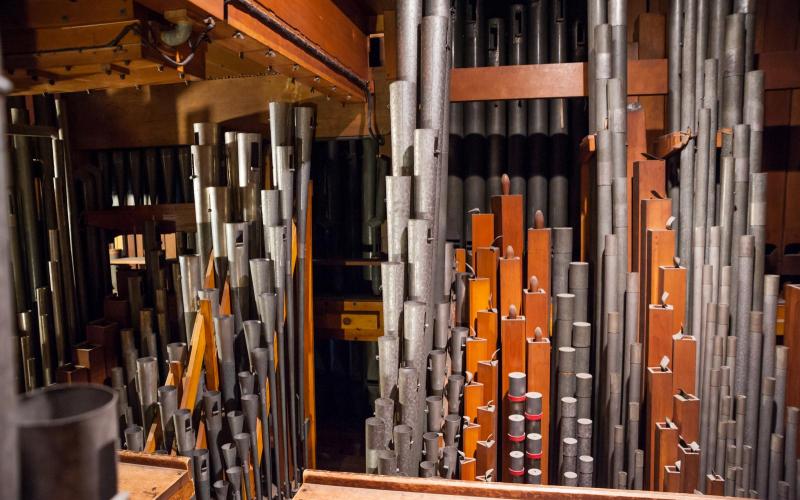
Some of the Swell Organ’s more than 2,500 pipes. The Swell Organ alone is larger than many medium-sized church organs.
-
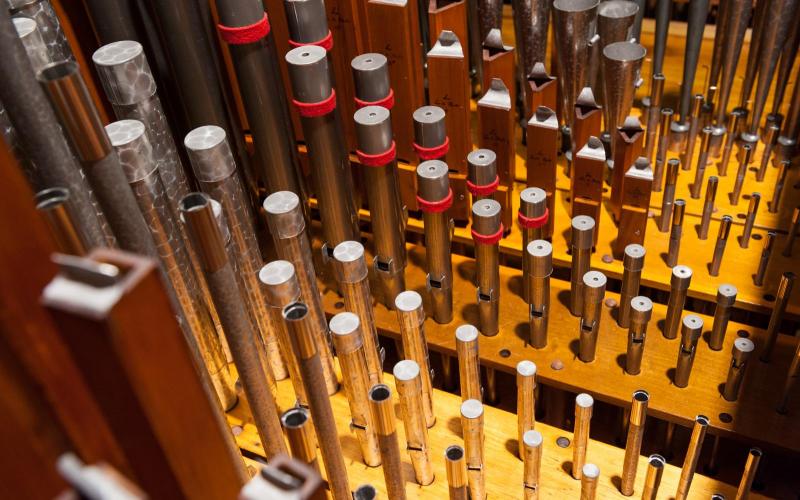
The pipework of the lower Swell Organ windchest after cleaning and restoration
-

These wooden pipes have had three names over the years. Originally installed in the Great Organ in 1903 and called Principal Flute, in the 1915 revision of the organ they were moved to the Swell Organ and renamed Tibia Plena. During the 1928 rebuilding of the organ they were renamed Open Flute and have kept that name ever since.
-
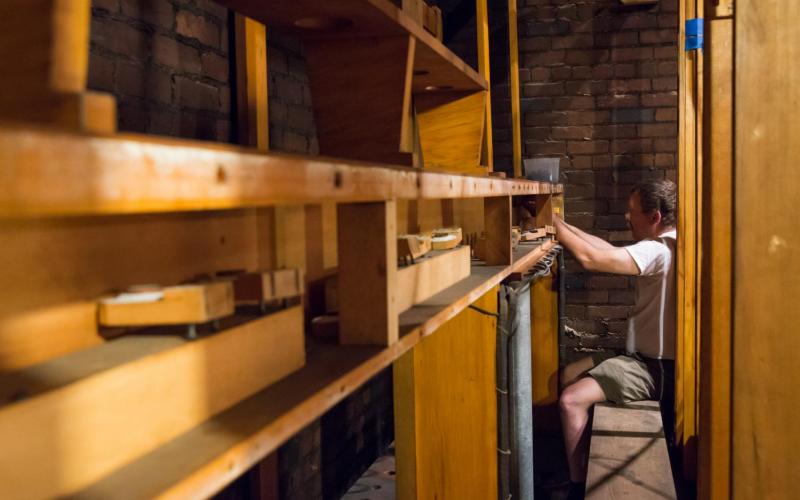
The largest pipes are installed on special “bass chests” to give them more speaking room and to reduce the size of the main windchests. Here a bass chest is being dismantled for restoration.
-
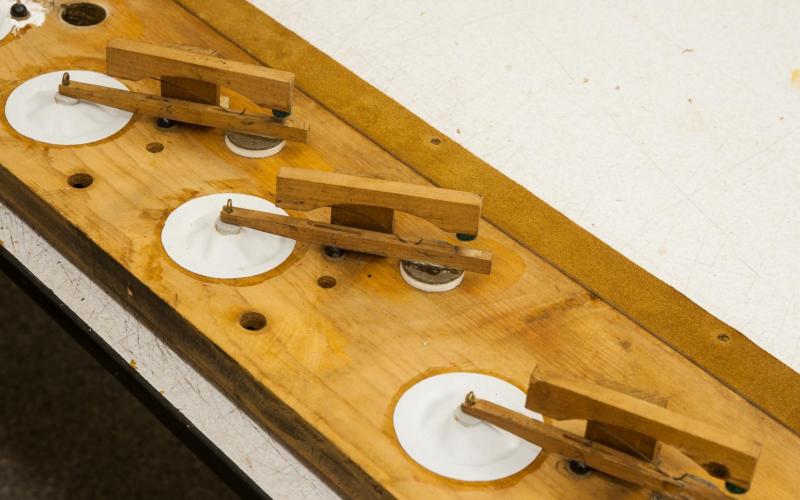
The mechanism, or “action” of a bass chest, made in 1903, receives new valves and white leather diaphragms as part of the restoration process.
-
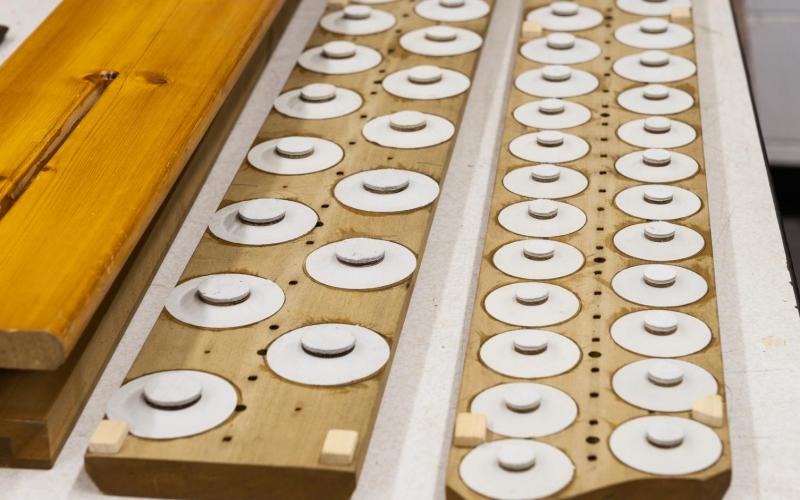
Some of the hundreds of new leather “pouches” and their valves. Internal springs push the disk valves shut against the pipe-holes. When the pouch is deflected under wind-pressure, air flows into the pipes above.
-
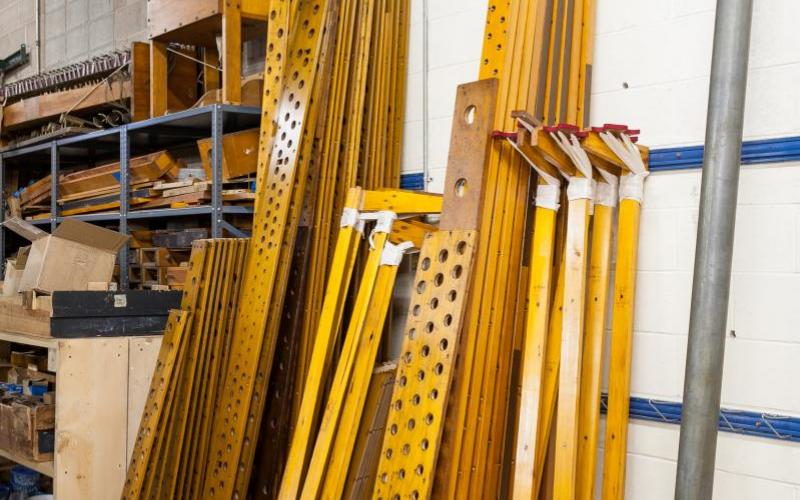
The woodwork of the windchests is cleaned and refinished using special shellac. Shiny surfaces promote the egress of sound into the Hall.
-
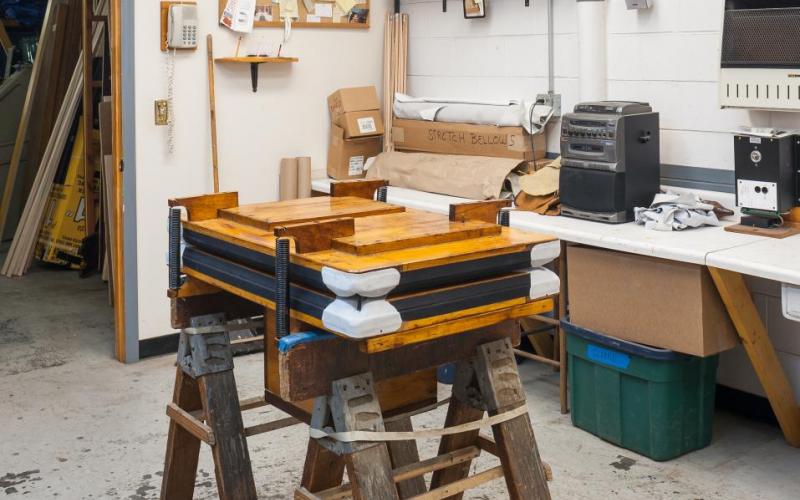
A wind-pressure regulator has been rebuilt with new leather corner gussets and hinges. This regulator is for the pipes of the two Pedal Organ mixture stops. Once installed it will serve for fifty or sixty years before it needs to be rebuilt again.
-
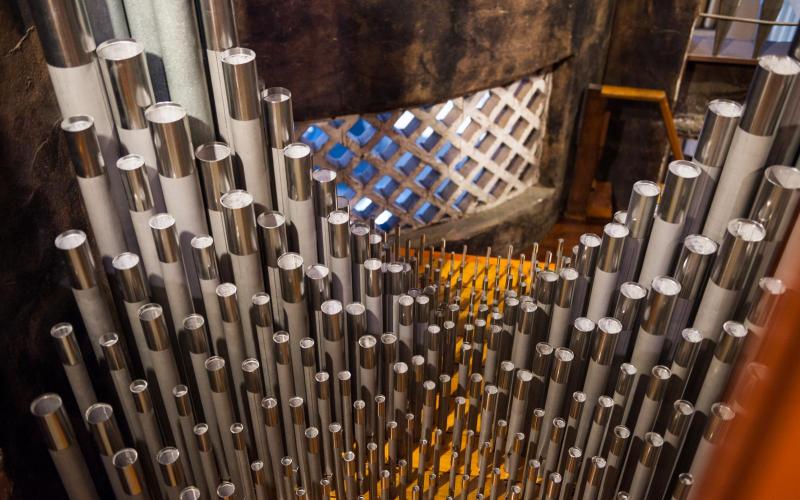
The two Pedal Organ mixture stops as seen from the expression shades of the Swell Organ chamber. The plaster grillwork in the background permits the sound to enter Woolsey Hall.
 Pipes of the 8-foot Geigen Diapason await cleaning and repair in the shop. This is the first time these pipes have been out of the organ since they were installed in 1903.
Pipes of the 8-foot Geigen Diapason await cleaning and repair in the shop. This is the first time these pipes have been out of the organ since they were installed in 1903. Swell Organ with façade grillwork. The two “perches” that straddle the two windchests permit the organ curators to reach every pipe for tuning.
Swell Organ with façade grillwork. The two “perches” that straddle the two windchests permit the organ curators to reach every pipe for tuning. Associate organ curator Nicholas Thompson-Allen prepares delicate pipes for transport in special blankets and wooden crates.
Associate organ curator Nicholas Thompson-Allen prepares delicate pipes for transport in special blankets and wooden crates. Pipework pre-resoration. L to r: 16’ Posaune, 4’ Clarion, 4’ Flute Triangulaire, 8’ Rohrflöte, 8’ Quintadena
Pipework pre-resoration. L to r: 16’ Posaune, 4’ Clarion, 4’ Flute Triangulaire, 8’ Rohrflöte, 8’ Quintadena Water damage is visible on the masonry of the chamber walls. No one has passed through the door (upper right) since 1915 when storm windows were installed over it.
Water damage is visible on the masonry of the chamber walls. No one has passed through the door (upper right) since 1915 when storm windows were installed over it. Vox Humana (Human Voice) pipes before restoration. Note the dust on the pipes and their windchest, as well as the water damage to the masonry wall behind the bass pipes in the photo.
Vox Humana (Human Voice) pipes before restoration. Note the dust on the pipes and their windchest, as well as the water damage to the masonry wall behind the bass pipes in the photo. Following restoration the pipes and windchest for the Vox Humana shine like new. The cleaning process has returned the original sheen to the sound of the organ that gradually had been muffled by the accumulation of dust.
Following restoration the pipes and windchest for the Vox Humana shine like new. The cleaning process has returned the original sheen to the sound of the organ that gradually had been muffled by the accumulation of dust. The Pedal Organ’s “mixture” pipework was a rarity in 1928. These pipes sound various pitches of the natural harmonic series, adding a special tint to the sound of the Pedal Organ.
The Pedal Organ’s “mixture” pipework was a rarity in 1928. These pipes sound various pitches of the natural harmonic series, adding a special tint to the sound of the Pedal Organ. Some of the Swell Organ’s more than 2,500 pipes. The Swell Organ alone is larger than many medium-sized church organs.
Some of the Swell Organ’s more than 2,500 pipes. The Swell Organ alone is larger than many medium-sized church organs. The pipework of the lower Swell Organ windchest after cleaning and restoration
The pipework of the lower Swell Organ windchest after cleaning and restoration These wooden pipes have had three names over the years. Originally installed in the Great Organ in 1903 and called Principal Flute, in the 1915 revision of the organ they were moved to the Swell Organ and renamed Tibia Plena. During the 1928 rebuilding of the organ they were renamed Open Flute and have kept that name ever since.
These wooden pipes have had three names over the years. Originally installed in the Great Organ in 1903 and called Principal Flute, in the 1915 revision of the organ they were moved to the Swell Organ and renamed Tibia Plena. During the 1928 rebuilding of the organ they were renamed Open Flute and have kept that name ever since. The largest pipes are installed on special “bass chests” to give them more speaking room and to reduce the size of the main windchests. Here a bass chest is being dismantled for restoration.
The largest pipes are installed on special “bass chests” to give them more speaking room and to reduce the size of the main windchests. Here a bass chest is being dismantled for restoration. The mechanism, or “action” of a bass chest, made in 1903, receives new valves and white leather diaphragms as part of the restoration process.
The mechanism, or “action” of a bass chest, made in 1903, receives new valves and white leather diaphragms as part of the restoration process. Some of the hundreds of new leather “pouches” and their valves. Internal springs push the disk valves shut against the pipe-holes. When the pouch is deflected under wind-pressure, air flows into the pipes above.
Some of the hundreds of new leather “pouches” and their valves. Internal springs push the disk valves shut against the pipe-holes. When the pouch is deflected under wind-pressure, air flows into the pipes above. The woodwork of the windchests is cleaned and refinished using special shellac. Shiny surfaces promote the egress of sound into the Hall.
The woodwork of the windchests is cleaned and refinished using special shellac. Shiny surfaces promote the egress of sound into the Hall. A wind-pressure regulator has been rebuilt with new leather corner gussets and hinges. This regulator is for the pipes of the two Pedal Organ mixture stops. Once installed it will serve for fifty or sixty years before it needs to be rebuilt again.
A wind-pressure regulator has been rebuilt with new leather corner gussets and hinges. This regulator is for the pipes of the two Pedal Organ mixture stops. Once installed it will serve for fifty or sixty years before it needs to be rebuilt again. The two Pedal Organ mixture stops as seen from the expression shades of the Swell Organ chamber. The plaster grillwork in the background permits the sound to enter Woolsey Hall.
The two Pedal Organ mixture stops as seen from the expression shades of the Swell Organ chamber. The plaster grillwork in the background permits the sound to enter Woolsey Hall.